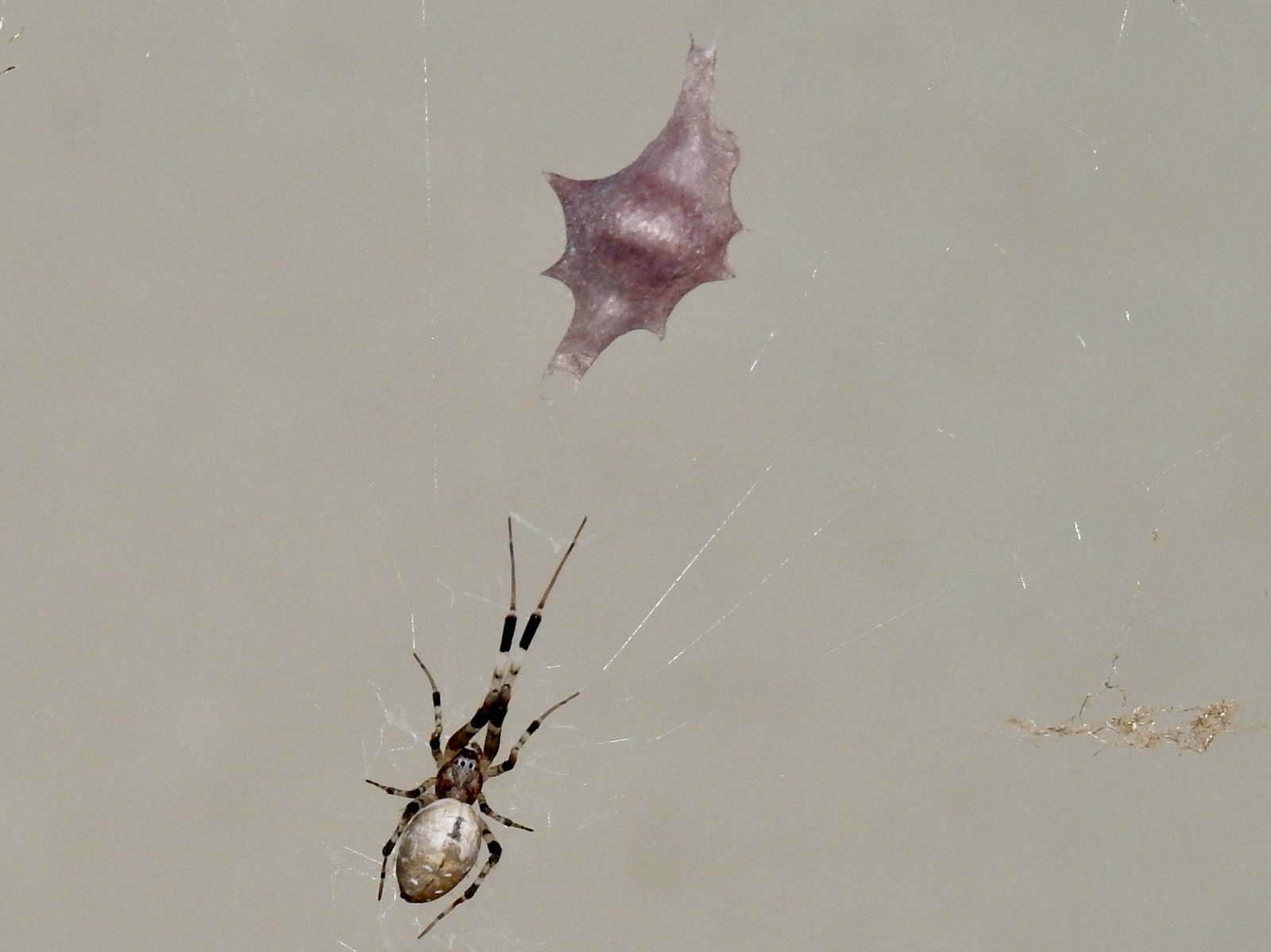Hackled orb-weavers
Venomless Spiders
Introduction
Hackled Orb-weavers, family Uloboridae, are also known as Venomless Spiders. Despite having no venom to assist them in subduing prey, Hackled Orb-weavers are a quite diverse and successful group. Several local and at least one introduced species occur commonly around houses in Australia
What do Hackled orb-weavers look like?
Identification
There are 12 species of Hackled Orb-weavers in five genera currently recognised in Australia. There are likely to be many more species and genera but the group has not been revised.
In the southeast of Australia, the spiders most commonly noticed are in the genus Philoponella. These have a characteristic ‘humped’ appearance, and in the web often rest with their front legs folded back underneath. The rear row of eyes is curved backwards at the ends, more strongly in some species than others, and well separated from the front row.
The silk combing organ, the calamistrum, on the rear legs is strongly bowed in females and this may be easily visible with a hand lens or in a macro photograph.

© CC-BY-NC 4.0
Some of these species make a single-line web while other spin more complex webs both solo or joined into colonies. In the colonial forms, the conjoined web mass is often more obvious than the individual spiders.
Complex webs are made of blueish, combed silk with an orb-web at the heart of the structure. This is not always obvious as the orb may be heavily modified and damaged with web segments often simply pushed aside and left as an extra section alongside a new web. This can create a messy, confusing overall structure.
Most webs also have stabilamenta, which are thicker ‘decorated’ silk sections or flecks and the communal species have many connecting lines. The spiders themselves are well camouflaged to look like detritus.
Spiders of the genus Miagrammopes have a slender body and only four eyes; on a silk line with legs extended they resemble small twigs, rolled leaflets or skeins of bark.

© Australian Museum
Where do Hackled orb-weavers live?
Habitat
Many species prefer sheltered habitats such as rock overhangs, cave entrances and hollow trees, where webs are less prone to regular damage by wind, rain and falling debris.
This preference for shelter makes many areas around and under human dwellings favourable habitat, and Philoponella pantherina is a common species around Sydney houses, whilst Zosis geniculatus is a species found in similar habitats in Brisbane and other subtropical and tropical areas.
Some species usually live in more exposed microhabitats among twigs or foliage, including the common Philoponella congregabilis, which as its name suggests is a communal species forming seasonal colonies up to about 1 m in diameter.

© CC-BY 4.0
Distribution
Hackled Orb-weavers have been recorded in all Australian states and territories, with most records from the more populated areas of the eastern seaboard. This bias is likely to be a product of where humans look for spiders rather than their true distribution because some genera are mainly tropical and sub-tropical and there are very few records from rocky ranges in Central Australia; both areas are almost certainly under-recorded.
Due to their affinity for human-modified environments, some species may get moved around by humans. Zosis geniculatus is a pantropical species that may be introduced to Australia, and the colonial Australian species Philoponella congregabilis, was recently discovered in New Zealand.
Lifecycle of Hackled orb-weavers
Life history
The egg sac of Philoponella pantherina has a base sheet of smooth creamish coloured silk guyed out in several directions and the egg covering is fluffy silk finished with bobbles.
Egg sacs of Zosis geniculatus are also asterisk-shaped but pinkish, whilst those of Philoponella congregabilis have a more elongate, spikey shape. Some Miagrammopes species make a smooth cigar-shaped egg sac. Egg sacs are usually guarded by the female spider.
Prey and predators
Hackled Orb-weavers, unlike orb weavers such as Garden Orb-weavers that use sticky silk, do not eat their old webs and so cannot recycle the silk proteins. Old web sections are pushed to one side, forming complex messy webs over time.
The combed silk, called cribellate silk, is very effective at snagging spiny insect legs. However, it is less strong than sticky silk, so large prey items are less commonly captured. Lacking venom glands, Hackled Orb-weavers rely on crushing their prey by wrapping with abundant silk.
Some communal species are more cooperative than others, many defend their own web area against their neighbours by shaking to warn them away. Single-line species hunt by keeping the line under tension and releasing a silk suddenly when prey, such as crane flies, land on the line.

© CC BY-NC 4.0
References
- Framenau, V.W., Baehr, B.C. and Zborowski, P. (2014), A Guide to the Spiders of Australia. New Holland.
- Vink, C. J. & Curtis, K. M. (2020). A redescription of Philoponella congregabilis, an Australian hackled orb weaver spider (Uloboridae) now found in Christchurch, New Zealand. Records of the Canterbury Museum 34: 85-94


